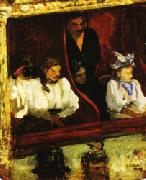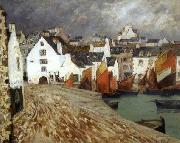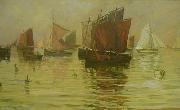Charles Cottet El petróleo que Pinta la ReproducciónAll Charles Cottet Oil PaintingsCharles Cottet (1863-1925), French painter, was born at Le Puy-en-Velay and died in Paris. A famed post-impressionist, Cottet is known for his dark, evocative painting of rural Brittany and seascapes. He led a school of painters known as the Bande noire or Nubians group (for the somber palette they used, in contrast to the brighter post-impressionist paintings), and was friends with such artists as Auguste Rodin. Cottet studied at the École des Beaux-Arts, and under Puvis de Chavannes and Roll, while also attending the Academie Julian (where fellow students formed Les Nabis school of painting, with which he was later associated). He travelled and painted in Egypt, Italy, and on Lake Geneva, but he made his name with his sombre and gloomy, firmly designed, severe and impressive scenes of life on the Brittany coast. Cottet exhibited at the Salon of 1889, but on a trip to Brittany in 1886 he had found his true calling. For the next twenty years he painted scenes of rural and harbor life, portraying a culture Parisians still found exotic. He is especially noted for his dark seascapes of Breton harbors at dawn, and evocative scenes from the lives of Breton fishermen. He was close friends with Charles Maurin, and his group included the painter Felix-Émile-Jean Vallotton. Cottet has often been associated with the picturesque seaside symbolism of the Pont-Aven School, though Vallotton famously painted Cottet as a leader of Les Nabis, beside Pierre Bonnard, Edouard Vuillard, and Ker-Xavier Roussel, in his Five Painters (1902-3; Kunstmuseum Winterthur). Cottet was more explicitly the leader of his own small movement, the Bande noire of the 1890s, which included Lucien Simon and Andre Dauchez, all influenced by the realism and dark colours of Courbet. |
|||

|
|||
|
|
|||
|
||||||||
| Charles Cottet Charles Cottet (1863-1925), French painter, was born at Le Puy-en-Velay and died in Paris. A famed post-impressionist, Cottet is known for his dark, evocative painting of rural Brittany and seascapes. He led a school of painters known as the Bande noire or Nubians group (for the somber palette they used, in contrast to the brighter post-impressionist paintings), and was friends with such artists as Auguste Rodin. Cottet studied at the École des Beaux-Arts, and under Puvis de Chavannes and Roll, while also attending the Academie Julian (where fellow students formed Les Nabis school of painting, with which he was later associated). He travelled and painted in Egypt, Italy, and on Lake Geneva, but he made his name with his sombre and gloomy, firmly designed, severe and impressive scenes of life on the Brittany coast. Cottet exhibited at the Salon of 1889, but on a trip to Brittany in 1886 he had found his true calling. For the next twenty years he painted scenes of rural and harbor life, portraying a culture Parisians still found exotic. He is especially noted for his dark seascapes of Breton harbors at dawn, and evocative scenes from the lives of Breton fishermen. He was close friends with Charles Maurin, and his group included the painter Felix-Émile-Jean Vallotton. Cottet has often been associated with the picturesque seaside symbolism of the Pont-Aven School, though Vallotton famously painted Cottet as a leader of Les Nabis, beside Pierre Bonnard, Edouard Vuillard, and Ker-Xavier Roussel, in his Five Painters (1902-3; Kunstmuseum Winterthur). Cottet was more explicitly the leader of his own small movement, the Bande noire of the 1890s, which included Lucien Simon and Andre Dauchez, all influenced by the realism and dark colours of Courbet. |
||||||||
|
|
||||||||
| Pintura identificación:: 11071 En el País en la costa, la Pena In the Country by the Sea,Sorrow 1908(salón de 1908) 8 ~ 8 ~ ~ X 11 ~ 3 3/4 ~ ~ (264 X 345 cm) 1908(salon of 1908) 8' 8'' x 11' 3 3/4''(264 x 345cm) |
||||||||
|
|
||||||||
| Pintura identificación:: 11072 En el país en la costa In the country by the sea 1898 (salón de 1898) Tripych: entrepaño central, 5 ~ 9 1/4 ~ ~ X 7 ~ 9 1/4 ~ ~ (176 X 237cm);left y el derecho ponen panel cada 5 ~ 9 1/4 ~ ~ X 3 176 X de ~ ( 119 cm) 1898(salon of 1898) Tripych:central panel,5' 9 1/4'' x 7' 9 1/4''(176 x 237cm);left and right panels each 5' 9 1/4'' x 3'(176 x 119cm) |
||||||||
|
|
||||||||
| Pintura identificación:: 11490 Loge en elOpera-Comique Loge at the Opera-Comique 1887 1 ~ 1 1/2 ~ ~ X 10 3/4 ~ ~ (34 X 27,5 cm) el Legado del artista, 1925 1887 1' 1 1/2''x 10 3/4''(34 x 27.5 cm)Bequest of the artist,1925 |
||||||||
|
|
||||||||
| Pintura identificación:: 90431 dimanche matin Oil on Cardboard, 38.6 x 46.1 in. / 98 x 117 cm. Date 1905-1907 cyf |
||||||||
|
|
||||||||
| Pintura identificación:: 91328 Sailors Oil on canvas. 74x118 cm Date 1900-1910 cyf |
||||||||
|
|
||||||||
|
| ARTISTA PREVIO PROXIMO ARTISTA | |||||||
|
|
||||||||
|
Charles Cottet Charles Cottet (1863-1925), French painter, was born at Le Puy-en-Velay and died in Paris. A famed post-impressionist, Cottet is known for his dark, evocative painting of rural Brittany and seascapes. He led a school of painters known as the Bande noire or Nubians group (for the somber palette they used, in contrast to the brighter post-impressionist paintings), and was friends with such artists as Auguste Rodin. Cottet studied at the École des Beaux-Arts, and under Puvis de Chavannes and Roll, while also attending the Academie Julian (where fellow students formed Les Nabis school of painting, with which he was later associated). He travelled and painted in Egypt, Italy, and on Lake Geneva, but he made his name with his sombre and gloomy, firmly designed, severe and impressive scenes of life on the Brittany coast. Cottet exhibited at the Salon of 1889, but on a trip to Brittany in 1886 he had found his true calling. For the next twenty years he painted scenes of rural and harbor life, portraying a culture Parisians still found exotic. He is especially noted for his dark seascapes of Breton harbors at dawn, and evocative scenes from the lives of Breton fishermen. He was close friends with Charles Maurin, and his group included the painter Felix-Émile-Jean Vallotton. Cottet has often been associated with the picturesque seaside symbolism of the Pont-Aven School, though Vallotton famously painted Cottet as a leader of Les Nabis, beside Pierre Bonnard, Edouard Vuillard, and Ker-Xavier Roussel, in his Five Painters (1902-3; Kunstmuseum Winterthur). Cottet was more explicitly the leader of his own small movement, the Bande noire of the 1890s, which included Lucien Simon and Andre Dauchez, all influenced by the realism and dark colours of Courbet. |
||||||||
|
|
||||||||
|
CONTACTE EEUU |










